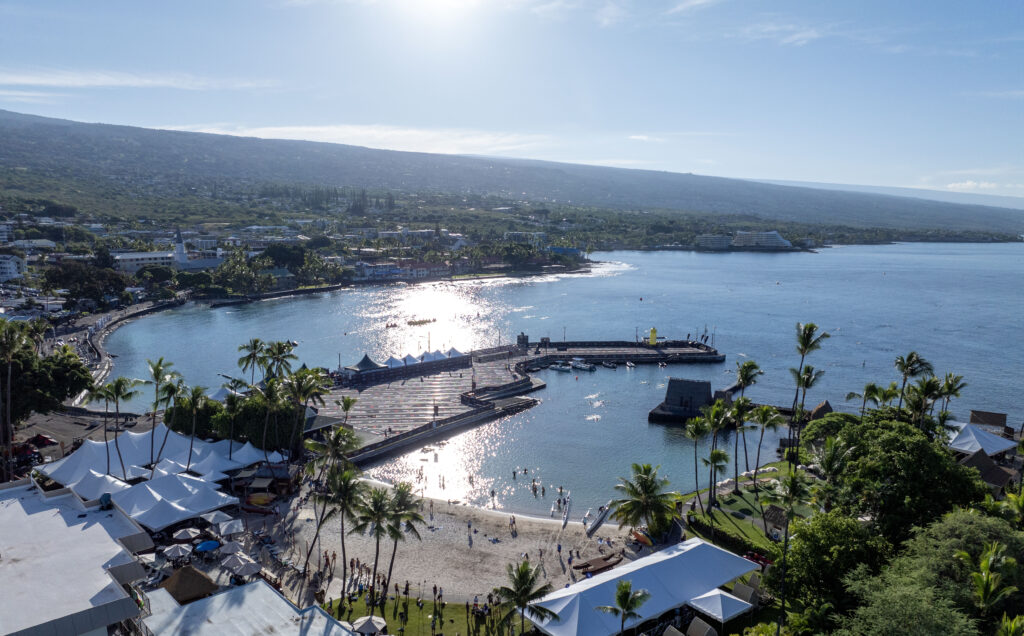IRONMAN Mostly Got it Right with New Kona Qualification Method

The IRONMAN World Championship returning to a single-day format in Kona, Hawaii was always going to introduce some pain points. Namely, who should be racing there? The initial backlash on a “mostly proportional” proposal was, well, a return to how qualifying as it once was, meaning that the more people in your age group starting on race day, the more chances you had available to you. Great if you’re a middle-aged man in lycra. Not so great if you’re a woman between 30 and 44 and racing fast, as you might have two slots available to your age group.
IRONMAN under a pre-Andrew Messick regime would have been in “damn the torpedoes, full speed ahead” mode. (Anybody remember the shocking response to the IRONMAN Passport program and the mea culpa issued by then-CEO Ben Fertic?) From Messick, and now onward to current CEO Scott DeRue, have been focused on introducing customer-centric programs and, more or less, delivering upon them. That’s where things like a transfer and deferral program have come from; actions unheard of in the IRONMAN selling out a full year in advance era.
So it wasn’t much of a surprise to hear that IRONMAN was going to pivot on how it would have athletes qualify for its respective world championships. To recap: we’re effectively introducing a handicap system to triathlon. Every age group is receiving a handicap, based off of performance at the IRONMAN World Championships in Kona by the top 20% within that age group. That figure is then multiplied by your actual time on race day at a given event to create your net time. Those net times are then ranked. Kona slots are first awarded to age group winners (or may roll to the podium within that age group); if those are not taken, they get re-allocated to the remainder pool. The remainder pool slots are then awarded off of net time order until they’re gone.
Naturally, the Slowtwitch Forum has been ablaze with commentary and calculations on this new system. Most reaction is positive; it’s rewarding the fastest athletes, relative to their age group, much in the same way that the Boston Marathon or other time-standardized qualification events do. Those athletes have, in general, not always come from age groups that feature the most population in them. You could have a race with 40 slots available where 12 men and 28 women qualify based on age group winners and net times. Or those numbers could be reversed.
In fewer words: your performance against the entirety of the field now matters, instead of just how many people in your age group show up to start.
This is, for the most part, a good move. For far too long, qualification was simply a matter of “how many of your fellow age groupers ponied up the dollars to start” and finishing well enough within that subset of racers. But, as we’ve seen for years in the most competitive women’s age groups, you could be in the top 10 overall women in the field and not wind up getting a slot because, well, there were just more men between the ages of 35 and 54 who decided to play triathlon that day. That math does not math. Nor does it comport with the current view that the IRONMAN World Championship should be about pure performance. (Let’s leave aside the Collins vision of “leave a slot for the everyday athlete on the pier” for today. That’s another article for another time.)
I think the most glaring miss out of just using top performances in Kona is that it will create courses that will over-index in certain age groups / strengths, and make forum shopping a more likely game than it was before. Take, for instance, a flatter / faster course, such as IRONMAN Florida or Arizona. On those courses there tends to be less of a delta between your overall fastest athletes and those in other age groups. Because of the current math on the handicap, where certain age groups see higher penalties in the heat / humidity / depending on when they start in Kona, you’ll likely see more older athletes earn slots at those events. On the flip side, take one of your more difficult courses, particularly those with more challenging bike courses. It’s likely that they will see more slots go to stronger riding athletes.
On the back of my napkin, I would have looked at creating handicaps that were more course class dependent, and based on results at those particular events, as opposed to solely attempting to create it off of performances in Kona. Say, bucketing races into three separate tiers based on their course characteristics, and then creating your grading system. But I also understand why IRONMAN is basing everything through Kona; first, for ease of the math problem. Secondly, well, branding is a hell of a drug. For better or for worse, Kona is synonymous with IRONMAN.
Now to start playing math to figure out where a mediocre near-40 year old might try to make hay while the sun shines…
Tags:
IRONMANIRONMAN World ChampionshipOpinionContinue the discussion at forum.slowtwitch.com
5 more replies




Hell that is easy, come to Malaysia with me in November.
Part of me is curious if they’ll one day jettison the 1 reserved slot for the age group winner.
Yes, I know it’s a sacrosanct in our sport - but it comes from the idea that everyone should be able to qualify somehow. Previously, we did this by ensuring there was at least 1 slot per age group. And this made sense when slots were allocated according to proportionality. No matter how many people show up, even it’s it’s only one or two, there’s at least one slot for the winner.
Now, IM has created a way to measure performance across age groups, so there’s less need to reward the Age Group winner - the top athletes will score high regardless of who else is in the field.
From the simulations, this really isn’t an issue at 50 slots - there’s usually only 1-3 age group winners who wouldn’t have gotten a slot via the age/gender adjusted time, so it’s not that big a deal.
But it does become a big deal if IM starts expanding again. In a world where most races have 30 slots, you’re going to start to see a lot of age group winners fall behind the top 30 competitive performances on the day. And it might actually matter at 40 slots - which we see about half the races having.
I’m not saying I agree with the idea that they should remove the reserved slot for the AG winner - that may be too far for the moment. But I’m just curious if it might ever come to that.
Anyway, food for thought. Probably less of an issue if they’re going to start expanding how many people get on the pier
Thank you for the article.
Allow me to suggest that language matters.
Let’s call the pool from which the non-class winners earn KQ as “performance pool” (not “remainder”).
It’s also the terminology IRONMAN uses:
“Any slot not claimed by an Age-Group winner will be offered to the second-place finisher in that age group, and if the second-place finisher does not accept the slot for any reason, it will be offered to the third-place finisher. If the first, second, and third-placed athletes all decline the slot, the slot is then returned to the overall performance pool and will be offered to the next-most deserving athlete based on the rank order of age-graded finish times.”
I think that’ll be a bridge too far, and as you allude too, time for IM to start doing some real estate hunting to get at min ~3k to the start list (I think that’s a nice round number that gets more to the island but also is race day manageable; not like they are going to find room for 5k for a 1 day race that is probaly just too much density for that race specific location)
This is somewhat in line with the idea of “you only got a slot because there’s a lot of slow people behind you with money who can afford to race.” – I don’t like that critique offered above by others and the main OP if we are going to recognize place by age group.
But it’s a true comment. To say some men only got a slot because there’s a bunch of slow ones registering behind them, means we should also say some slow and older women and men only got a slot because no one else signed up.
But those older AGs are inspirational and we all love watching them hunch forward march across the finish line.
Is there no love for the middle aged patent attorney?
Let the Age Group winner take the slot but no roll down. There are quite a few (10% of performance pool slots) podium places going to athletes way down the overall normalized ranking. If you’re 455th overall but 3rd in a small Age Group, cant see how thats rewarding performance.
I think the hybrid (class winner with roll down) and the remainder of the events allocation from the performance metric is fair.
I suggest that including the podium roll down makes it likely IRONMAN have at least one KQ from every AG from every race.
A side effect, which might be a secondary benefit, is that it encourages the complete podium to turn up for the (Prizegiving and) Awards shindig.
When Kona was announced for 1 day only moving forward we were all theorizing and debating the “equality” of m/f. In a way every AG winner essentially “equalizes” it and then it’s just an performance list after that regardless of gender. With whatever other initiatives/programs they want to use to fill out the final 600-800 likely spots.
I dig the new strategy, I didn’t see that as being the chosen path and it seems like they sorta came out of LF with ith, but major kudos, that’s for sure. It atleast on paper makes Kona feel like a more “true-er” WC…and yes I know, I know there are a bunch of pathways to “qualify” and fill out that race.
Having one from every age group (or likely one, anyway) also provides data for next year’s Kona. If M60 is slacking across the board, for example, then whomever does qualify provides another data point (likely slower) for the next set of coefficients.
Don’t threaten me with a good time…
.The ride through southern Thailand to Laguna Phuket in-between races will really be a good time…Maybe Ironmandad will make another guest appearance in Phuket to buy the beers.
I love my patent attorneys. They absoluately rock if you’re a tech startup trying to create freedom to operate and protect your biz. For triathlon, I don’t know, but if I could go biking and swimming with my patent law team, now that would be a bonus…can you recommend any that I can bike with?
I looked at flights and died a bit inside.
too many dollars at the moment.
Yep…Same reason I haven’t been back to Nth America since before The Pandemic
If I can get the former Slowtwitch Tundra Division office sold, we can have that conversation. Although likely wouldn’t be until 2026, given that my max run since last summer’s Great Pelvis Break incident is…4 miles.